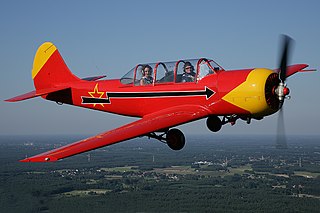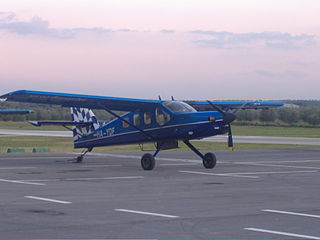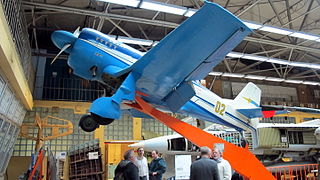
The Yakovlev Yak-52 is a Soviet primary trainer aircraft which first flew in 1976. It was produced in Romania from 1977 to 1998 by Aerostar, as Iak-52, which gained manufacturing rights under agreement within the former COMECON socialist trade organisation. The Yak-52 was designed as an aerobatic trainer for students in the Soviet DOSAAF training organisation, which trained civilian sport pilots and military pilots. Currently the Yak-52 is used in the Fédération Aéronautique Internationale (FAI) World Aerobatic Yak 52 Competition, a popular powered aircraft one-design World Aerobatic Championship.

The Sukhoi Su-26 is a single-seater aerobatic aircraft from the former Soviet Union, powered by a single radial reciprocating engine. The Su-26 has mid-mounted straight wings and fixed landing gear, the main gear mounted on a solid titanium arc.

The Zivko Edge 540 manufactured by Zivko Aeronautics is a highly aerobatic aircraft. Capable of a 420 degree per second roll rate and a 3,700 foot per minute climb rate, it has been flown to victory on the international Unlimited aerobatics circuit several times since the mid-1990s. A tandem-seat version is sold as the Edge 540T.

The Extra Flugzeugbau EA300 is a two-seat aerobatic monoplane capable of Unlimited category competition. It was designed in 1987 by Walter Extra, a German aerobatic pilot, and built by Extra Flugzeugbau.

The Mil Mi-34 is a light helicopter designed by the Mil Moscow Helicopter Plant in either a two or four seat configuration for utility and training. It was first flown on 17 November 1986 and introduced at the Paris Air Show in 1987. The Mi-34 entered production in 1993, and is capable of performing aerobatic manoeuvres, including rolls and loops.

The Yakovlev Yak-54 is a 1990s Russian aerobatic and sports competition aircraft designed by the Yakovlev Aircraft Corporation.

The Yakovlev Yak-18T is a four- or five-seat fully aerobatic utility aircraft developed by Yakovlev. Introduced to train Aeroflot pilots, it has gained some popularity as a sportplane both inside and outside the former USSR. It is powered by a 268-298 kW (360-400 hp) Vedeneyev M14P radial engine, and is designed for stresses of +6.48/-3.24 g.

The PZL 130 Orlik is a Polish turboprop, single engine, two seat trainer aircraft.

The Yakovlev Yak-55 is a single-seat aerobatic aircraft. Pilots flying the Yak-55 have won several world aerobatic championships.

The Sukhoi Su-29 is a Russian two-seat aerobatic aircraft with a 268 kW radial engine. It was designed based on the Su-26 and inherited most of the design and technical features of its predecessor. Due to wide use of composite materials, which make up as much as 60% of the Su-29's aircraft structure, the empty weight is increased by only 50 kg over the single-seat Su-26's empty weight.

The Sukhoi Su-6 was a Soviet ground-attack aircraft developed during World War II. The mixed-power high-altitude interceptor Su-7 was based on the single-seat Su-6 prototype.
The Sukhoi Su-8 or DDBSh was a Soviet prototype ground-attack aircraft of World War II.

The Sukhoi Su-31 is a Russian single-engined aerobatic aircraft designed by Sukhoi as a lighter and more powerful version of the Sukhoi Su-29.

The PZL-105 Flaming (flamingo) is a Polish short-takeoff-and-landing (STOL) utility aircraft designed by PZL "Warszawa-Okęcie". It remained a prototype.

The Yakovlev Yak-50 aerobatic aircraft is a single-seat all-metal low-wing monoplane with retractable main wheels and exposed tail wheel. The control surfaces are fabric-covered to save weight. The aircraft is not equipped with flaps.

The Technoavia SM92 Finist is a utility aircraft with a STOL capability, designed by the Russian company Technoavia. The maiden flight was on 28 December 1993. It is built by the Smolensk Aviation Plant.
The Yakovlev Yak-58 is a small, multi-role utility transport and business aircraft. The aircraft features a pusher engine and twin boom tail. It saw limited production in the late 1990s.

The MAI Kvant was a Soviet aerobatic trainer designed by students at the Moscow Aviation Institute. In October 1967 the aircraft was displayed at the Economic Achievement Exhibition in Moscow. The Kvant was a single-seat low-wing monoplane with a retractable main landing gear and a fixed tailwheel. It was powered by a 360 hp (268 kW) Vedeneyev M14P radial engine. The aircraft held five official FAI world records.
The Aviatika-900 Acrobat is a 1990s Russian single-seat aerobatic monoplane designed and built by Aviatika Joint Stock Company. The aircraft is sometimes referred to as the MAI-900 Acrobat, the Moscow Aviation Institute being one of the constitute organisations when the company was formed in 1993.

The Culp Special is an American aerobatic homebuilt aircraft designed and produced by Culp's Specialties of Shreveport, Louisiana. The aircraft is supplied as a kit or in the form of plans for amateur construction.

















